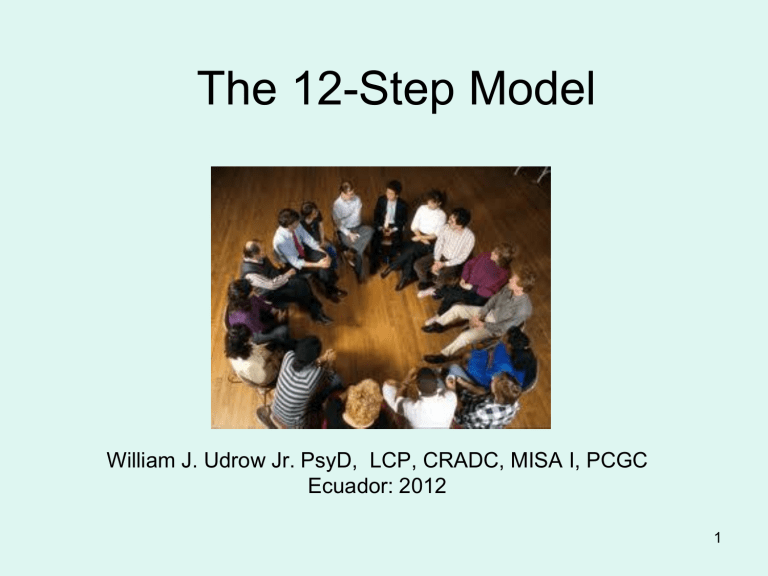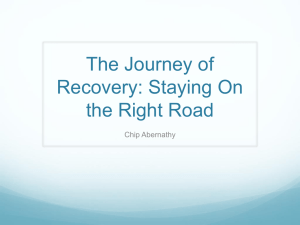Alcoholics Anonymous - Congresos en el Pacífico

The 12-Step Model
William J. Udrow Jr. PsyD, LCP, CRADC, MISA I, PCGC
Ecuador: 2012
1
Participation in Drug Abuse Treatment and 12-Step Program
Improved Treatment Outcomes: Percentage of patients remaining drug-free in the 6 months prior to follow-up. 12-step meetings after treatment almost doubles the abstinence rate of patients (48% vs. 86.4 %).
(Fiorentine, 1999)
90
80
70
60
50
40
30
20
10
0
Tx Dropout Tx
Completer s
Tx & 12
Steps
2
2000 International Conventions
Over 50,000 attendees. Amazingly, over 50% had over 11 years + sobriety
3
The 12-Step Model
What is the single, most effective program for the treatment of alcoholisms? That program, of course, is Alcoholics Anonymous, best known as
A.A. Alcoholics Anonymous is a worldwide fellowship of men and women who share their experience, strength, and hope with each other in an effort to recover from alcoholism.
A.A.is based upon a program of Twelve Steps to recovery that act as a personal guide to sobriety.
Knowledge of the Twelve Steps is of critical importance to recovering persons for two reasons:
4
The 12-Step Model
1. The steps work if you work them.
2. The Twelve Step programs are inexpensive and readily available in most communities. As a result, they are the most widely used lifeline for people recovering from chemical dependence, codependence, and other compulsive or addictive disorders.
(Gorski, 1989)
5
The 12-Step Model: Types
AA, Alcoholics Anonymous
NA, Narcotics Anonymous
GA, Gamblers Anonymous
SA, Sexaholics Anonymous
NA, Nicotine Anonymous
CA, Cocaine Anonymous
MA, Marijuana Anonymous
OA, Overeaters Anonymous
DA, Debtor Anonymous
ACoA, Adult Children of
Alcoholics
Al-Anon, for families of
Alcoholics
Alateen, for teenagers with alcoholic relatives.
6
The 12-Step Model
History:
In 1934 Bill Wilson a main character in the “Big
Book” of Alcoholics Anonymous was the first person to use the principles of the 12-Steps to patients recovering from alcoholism in hospitals.
It is believed that while Bill Wilson was still drinking he was heavily influenced by Ebby
Thatcher who was a member of the Oxford
Group as described in Bill’s Story, a chapter in the Big Book of Alcoholics Anonymous.
7
The 12-Step Model
Bill Wilson & Ebby Thatcher
8
The 12-Step Model
History:
The Oxford Group used Biblical concepts as a way for people to recover for alcoholism. There is research that suggests that the 12-Steps may have involved directly from the following Biblical ideas: (1) Men are sinners. (2) Men can be changed. (3) Confession is prerequisite to change. (4) The changed soul has direct access to God. (5) The Age of Miracles has returned. (6)
Those who have been "changed" must "change" others.
(Silkworth, 2012)
.
9
The 12-Step Model
Central to the disease model is the idea that the disease takes away the person’s control of his/her own drinking/using behavior and therefore removes the BLAME for the problem.
A.A. members are quick to point out that removing the blame for the disease does not remove the responsibility for dealing with their addictive behavior.
(Ray & Ksir, 2002).
10
The 12-Step Model
Analogy: We would not blame diabetics for being diabetic, but we do expect diabetics to control their diets, take their medication, etc….
Therefore, the person with the addictive behavior is seen as having the responsibility for managing the disease on a day-by-day basis but need not feel guilty about being different.
Member of A.A. support each other in difficult times through A.A. meeting, buddy systems, online support and sponsorship.
11
The 12-Step Model
Levels of Twelve Step Involvement:
1)Attending meetings
2)Reading and discussing A. A. literature
3)Getting a sponsor
4)Working the Twelve Steps
5)Sponsoring others
6)Service guided by the Traditions
(Gorski, 1989)
12
The 12-Step Model
1. Attending meetings:
A.A. stresses the importance of attending meeting, especially during the first three months of sobriety (90/90).
The principle that underlies doing “ninety in ninety” is a simple one—the more meetings you attend early on, the greater your chances of long-term recovery. Individual are able to build sober social skills. There are many different types of meets:
13
The 12-Step Model
Attending meetings: Different Types
Open Meetings , Everyone is Welcome. The group has voted to allow all comers to attend the meeting, although usually only individuals with alcohol and/or addictive behaviors speak.
Closed Meetings, The group has voted attendance is limited to alcoholics only.
BB, Big Book, The book Alcoholic Anonymous
(the Big Book) is the text for these meetings.
D, Discussion, The chairperson talks about his/her experience, strength and hope which is followed by an attendee’s discussion.
14
The 12-Step Model
Attending meetings: Different Types
P, Promises, The Promises of Alcoholics
Anonymous are on pages 82 and 83 of the Big
Book.
S, Steps, Using the book Twelve Steps and
Twelve Traditions (12 & 12) the meeting focuses on the Steps.
B, Beginners, These meetings are usually led by more experienced group members with the primary focus on introducing new members to the tools available for the maintenance of sobriety.
15
The 12-Step Model
2. Reading and discussing A. A. literature:
Alcoholics Anonymous (Big Book)
Twelve Steps and Twelve Traditions
16
The 12-Step Model
3. Getting a sponsor:
A sponsor is another member of the Twelve
Step program who has more experience at recovery than the sponsee. Find a sponsor who has the type of recovery you would like to have.
17
The 12-Step Model
Qualities to look for when selecting a sponsor:
Have at least one year of sobriety.
Have a sponsor himself or herself (Grandsponsor).
Realize the importance of the Steps and be willing to help us work them.
Have personally worked at least the first five steps.
Promise to hold everything we say in strict confidence.
18
The 12-Step Model
Qualities to look for when selecting a sponsor:
Be regularly available.
Emphasize that Alcoholics Anonymous
Feel comfortable discussing the spiritual
Remind us that we are always free to find an additional sponsor or a replacement sponsor
(anonymous, 2001)
19
The 12-Step Model
4. Working the Twelve Steps:
People who genuinely want to recover do more than just go to meetings: They work the Steps under the guidance of their sponsor. To quote the
Big Book, “Rarely have we seen a person fail who has thoroughly followed our path.”
(Alcoholics Anonymous,
2001)
Working the steps promotes a program of Honesty,
Open-mindedness and Willingness (HOW) to change. These three concepts correspond to first three Steps respectively.
(Inaba & Cohen,2000)
20
THE TWELVE STEPS OF A.A.
1. We admitted that we were powerless over alcohol —that our lives had become unmanageable. * HONESTY
2. Came to believe that a Power greater than ourselves could restore us to sanity. . * HOPE
3. Made a decision to turn our will and our lives over to the care of God as we understood Him. *FAITH
4. Made a searching and fearless moral inventory of ourselves. * COURAGE
5. Admitted to God, to ourselves, and to another human being the exact nature of our wrongs. * INTEGRITY
6. Were entirely ready to have God remove these defects of character. * WILLINGNESS
(* The spiritual principle behind each step)
21
THE TWELVE STEPS OF A.A.
7. Humbly asked Him to remove our shortcomings. * HUMILITY
8. Made a list of all the persons that we had harmed, and became willing to make amends to them all. * BROTHERLY LOVE
9. Made direct amends to such people wherever possible, except when to do so would injure them or others. * JUSTICE
10. Continued to take personal inventory and when we were wrong promptly admitted it. * PERSEVERANCE
11. Sought through prayer and meditation to improve our conscious contact with God as we understood Him, praying only for the knowledge of His will for us and the power to carry it out.
* SPIRITUALITY
12. Having had a spiritual awakening as a result of these steps, we tried to carry this massager to alcoholics, and to practice these principles in all our affairs. * SERVICE
(* The spiritual principle behind each step)
22
The 12-Step Model
5. Sponsoring others:
By attending meetings, reading Twelve Step literature, talking frequently with sponsors and working the Steps, people in recovery begin to grow and change.
Sponsoring is a two-way street: As sponsors answer questions and help sponsees the sponsor grows in his recovery. Sometimes the sponsor has to turn to his/her sponsors who are grandsponsors to the original sponsee.
23
The 12-Step Model
6. Service guided by the Traditions:
Every organization needs bylaw. The twelve fundamental bylaws that govern the operation of
Twelve Step programs are called the Traditions.
(Gorski, 1989)
The Traditions set forth the purpose of the fellowship, which is to carry it message to the stillsuffering alcoholic. The focus of the traditions: sobriety, anonymity, individual application of the
“program” which include meetings, attempting to work the twelve steps and service to other alcoholics
(Kinny, 2000)
24
THE TWELVE TRADITIONS OF A.A.
1 Our common welfare should come first; personal recovery depends on
A.A. unity.
2 For our group purpose there is but one ultimate authority – a loving
God as he may express Himself in our group conscience. Our leaders are but trusted servants; they do not govern.
3 The only requirement for A.A. membership is a desire to stop drinking.
4 Each group should be autonomous except in matters affecting other groups or A.A. as a whole.
5 Each group has but one primary purpose – to carry its message to the alcoholic who still suffers.
6 An A.A. ought never endorse, finance, or lend the A.A. name to any related facility or outside enterprise, lest problems of money, property, and prestige divert us from our primary purpose.
25
THE TWELVE TRADITIONS OF A.A.
7 Every A.A. group ought to be fully self-supporting, declining outsides contributions.
8 Alcoholics Anonymous should remain forever non-professional, but our service centers may employ special workers.
9 A.A., as such, ought never be organized; but we may create service boards, or committees directly responsible for those they serve.
10 Alcoholics Anonymous has no opinion on outside issues; hence the
A.A. name ought never be drawn into public controversy.
11 Our public relations policy is based on attraction rather than promotion; we need always maintain personal anonymity at the level of press, radio, and films.
12 Anonymity is the spiritual foundation of all our traditions, ever reminding us to place principles before personalities.
26
The 12-Step Model
A couple of useful websites resources
• 12 Step Café Home Page http://www.12steps.org/
• 12step.org for sobriety, strength and serenity http://www.12step.org/
• 12 Step Café Recovery Links http://www.12steps.org/12stephelp/12steplinks.htm
27
12-Step Slogan
28
29
Reference
Alcoholics Anonymous Big Book 4th Edition (2001). New York :Alcoholics
Anonymous World Services, Inc.
Anonymous (2001). Call Your Sponsor. Haymarket Center.
Fiorentine, R. (1999). After drug treatment: Are 12-step programs effective in maintaining abstinence? American Journal of Drug and Alcohol Abuse. 25(1), 93-116.
Gorski, T. T., (1989). Understanding the Twelve Steps: A Guide for Counselors,
Therapists, and Recovering People.
Independence, MO: Herald House Press.
Inaba, S. D. & Cohen, E. W. (2000). Uppers, Downers, All Arounders :
Physical and Mental Effects of Psychoactive Drugs. Oregon: CNS
Publications, Inc.
Kinny, J. (2000). Loosening the Grip: A Handbook of Alcohol Information.
United States: The McGraw-Hill Companies, Inc.
30
Reference
Ray, O. & Ksir, C. (2002). Drugs, Society and Human Behavior : New York,
New York: The McGraw-Hill Companies, Inc
Silkworth.net (September 9, 2012). The Oxford Group and Alcoholics Anonymous: http://silkworth.net/aahistory/oxford_group_connection1.html
31










